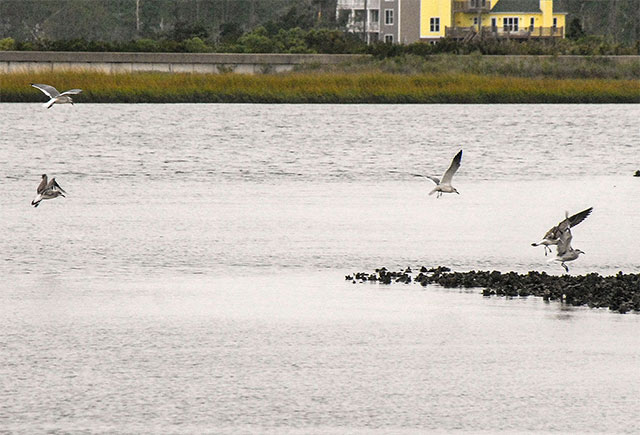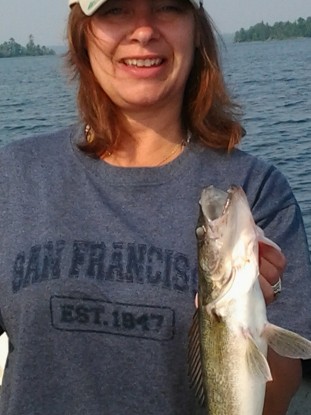
I grew up bass fishing in freshwater lakes. When fishing lakes for bass, everything looks good: vegetation, docks, laydowns, standing timber, seawalls, bushes, rip rap, chunk rock banks. The point is, no matter what kind of lake you go to, there is usually no shortage of something “fishy looking” to toss a lure at.
In saltwater, though, things can be dramatically different; everything looks the same for miles and miles. This aspect of saltwater fishing can be daunting. So where should you turn for help? Or better yet, where should you tern for help?
You got it, the birds!
And what if there are no birds in sight? Fear not, you have friends in and around the brine that can help you. Bays and oceans are so vast that any little sign of life out there can be a huge signpost pointing you to the fish.
Birds are an obvious starting point since they are the easiest to spot from a distance. Nothing spells out “FISH FEEDING HERE!” like a swarm of gulls, terns, pelicans or a combination of all diving into the water. A “bird tornado” swirling above the water is a captain’s delight. Upon nearing the dipping and diving birds, it’s usually easy to see baitfish being pushed to the surface by something bigger feeding underneath.
But it does not always take a quintessential bird tornado to give away the fish’s location. Some of the best redfish schools I’ve found were revealed by one or two little terns diving along a vast, featureless line of marsh grass. Any kind of bird activity along a seam where game fish can push baitfish up against a bank, oyster bar or shoal is golden. Birds are always patrolling these seams and junctures looking for baitfish being herded against a barrier and when they start “dipping,” it’s a good thing.
Birds don’t always need to be “in action” by diving and feeding to give away fish locations, either. One of my favorite sights is to see a group of mixed birds – gulls, terns and pelicans – all sitting on a beach together. They are not all sitting together just to get a suntan. Many times they are sitting there digesting baitfish they have just plucked from a feeding frenzy nearby.
In the fall months, I’ll run the beaches in front of barrier islands looking for a group of birds sitting on the beach and start searching for bait pods around those birds.
A bunch of birds sitting on one particular buoy or range marker, and not any of the others, is another scenario worth investigating.
When fishing back in bays and estuaries, keep an eye out for those herons and egrets – especially ones “on point,” on a point.
Birds alone are not the only signposts that can point out fish: schools, groups and swarms of anything should be investigated.
I once found dozens of cannonball jellyfish lined up in a current rip on the inside of an inlet during an incoming tide. The scenario looked interesting, so I flicked a Gulp Shrimp along the rift line where the jellyfish were bobbing, let it sink to the bottom, and instantly caught a fat flounder. I proceeded to load the boat with flounder on that seam of current. I had to cast right in the seam where the jellyfish were and “drift” my ¼-ounce jig back with the incoming current to get the flounder to bite. Whatever those jellyfish were getting out of that current mix, the flounder were digging it, too, and I would have never caught those flounder without the proliferation of jellyfish grabbing my attention.
On another occasion, I was enduring a fishless winter day in a bay when I noticed a family of raccoons up along the marsh grass, feeding on something at the water’s edge. I started fishing towards their direction to see what they were feasting on; I’m only guessing they were eating fiddler crabs. As I approached, I saw a redfish wiggle himself into inches of water to sample whatever it was the raccoons were wading in the water for. I switched up to my longest-casting spinning rod to reach the feeding table and caught two nice reds to salvage my fishless day. I would have never caught those reds if I had not seen the raccoons and went to investigate what they were doing.
Saltwater environments can be vast, featureless places, so always be on the lookout for anything and everything – diving birds, wading birds, even resting birds, schools of mullet, flocks of rays, jumping rays, sea turtles, even raccoons on the bank. Life in and around the ocean is not random; everything is happening for a reason, usually something eating something else, which can be the little clue you need to find the fish.
The importance of individual soccer drills for developing your game


Walleye Fishing Mid Summer 2013

Copyright © www.mycheapnfljerseys.com Outdoor sports All Rights Reserved